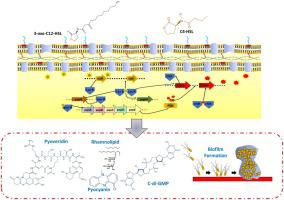当前位置:
X-MOL 学术
›
Process Biochem.
›
论文详情
Our official English website, www.x-mol.net, welcomes your
feedback! (Note: you will need to create a separate account there.)
Biofilm and Quorum sensing mediated pathogenicity in Pseudomonas aeruginosa
Process Biochemistry ( IF 3.7 ) Pub Date : 2020-09-01 , DOI: 10.1016/j.procbio.2020.06.001 Kathirvel Brindhadevi , Felix LewisOscar , Eleftherios Mylonakis , Sabarathinam Shanmugam , Tikendra Nath Verma , Arivalagan Pugazhendhi
Process Biochemistry ( IF 3.7 ) Pub Date : 2020-09-01 , DOI: 10.1016/j.procbio.2020.06.001 Kathirvel Brindhadevi , Felix LewisOscar , Eleftherios Mylonakis , Sabarathinam Shanmugam , Tikendra Nath Verma , Arivalagan Pugazhendhi

|
Abstract The emergence of multidrug resistance has become an alarming and lifethreatening phenomenon for humans. Various mechanisms are involved in the development of resistance in bacteria towards antimicrobial compounds and immune system. Bacterial biofilm is a complicated, selfdefensive, rigid structure of bacteria crowded together to develop a selfrecessive nature, which enhances the ability to cause infections much easier in the living host. P. aeruginosa biofilm formation is supported by extracellular polymeric substances (EPS) such as exopolysaccharides, extracellular DNA (eDNA), proteins and biomolecules. Published evidences suggest that biofilm formation can also be the result of several other mechanisms such as cell signaling or communication. Bacterial biofilm is also regulated by strong intercellular communication known as Quorum Sensing (QS). It is a cellular communication mechanism involving autoinducers and regulators. In P. aeruginosa, Acyl Homoserine Lactone, the prime signaling molecule, controls approximately 300 genes responsible for various cellular functions, including its pathogenesis. The surrounding environment and metabolism have a specific effect on the biofilm and QS, thus, understanding the involvement of QS in the biofilm developing mechanism is still complicated and complex to understand. Therefore, this review will include basic knowledge of the biofilmforming mechanism and other regulatory factors involved in causing infections and diseases in the host organisms.
中文翻译:

生物膜和群体感应介导的铜绿假单胞菌致病性
摘要 多药耐药性的出现已成为一种令人震惊和危及人类生命的现象。细菌对抗菌化合物和免疫系统产生耐药性的过程涉及多种机制。细菌生物膜是一种复杂的、自卫的、刚性的细菌结构,它们挤在一起形成了一种自我隐性的特性,这增强了在活宿主中更容易引起感染的能力。铜绿假单胞菌生物膜的形成由胞外聚合物 (EPS) 支持,例如胞外多糖、胞外 DNA (eDNA)、蛋白质和生物分子。已发表的证据表明,生物膜的形成也可能是其他几种机制的结果,如细胞信号或通讯。细菌生物膜也受称为群体感应 (QS) 的强细胞间通讯调节。它是一种涉及自诱导剂和调节剂的细胞通信机制。在铜绿假单胞菌中,主要信号分子酰基高丝氨酸内酯控制着大约 300 个负责各种细胞功能的基因,包括其发病机制。周围环境和代谢对生物膜和QS有特定的影响,因此,理解QS在生物膜发育机制中的参与仍然是复杂和复杂的。因此,本综述将包括生物膜形成机制的基础知识和其他在宿主生物中引起感染和疾病的调节因素。铜绿假单胞菌,酰基高丝氨酸内酯,主要信号分子,控制着大约 300 个负责各种细胞功能的基因,包括其发病机制。周围环境和代谢对生物膜和QS有特定的影响,因此,理解QS在生物膜发育机制中的参与仍然是复杂和复杂的。因此,本综述将包括生物膜形成机制的基础知识和其他在宿主生物中引起感染和疾病的调节因素。铜绿假单胞菌,酰基高丝氨酸内酯,主要信号分子,控制着大约 300 个负责各种细胞功能的基因,包括其发病机制。周围环境和代谢对生物膜和QS有特定的影响,因此,理解QS在生物膜发育机制中的参与仍然是复杂和复杂的。因此,本综述将包括生物膜形成机制的基础知识和其他在宿主生物中引起感染和疾病的调节因素。理解 QS 在生物膜发展机制中的参与仍然很复杂,理解起来很复杂。因此,本综述将包括生物膜形成机制的基础知识和其他在宿主生物中引起感染和疾病的调节因素。理解 QS 在生物膜发展机制中的参与仍然很复杂,理解起来很复杂。因此,本综述将包括生物膜形成机制的基础知识和其他在宿主生物中引起感染和疾病的调节因素。
更新日期:2020-09-01
中文翻译:

生物膜和群体感应介导的铜绿假单胞菌致病性
摘要 多药耐药性的出现已成为一种令人震惊和危及人类生命的现象。细菌对抗菌化合物和免疫系统产生耐药性的过程涉及多种机制。细菌生物膜是一种复杂的、自卫的、刚性的细菌结构,它们挤在一起形成了一种自我隐性的特性,这增强了在活宿主中更容易引起感染的能力。铜绿假单胞菌生物膜的形成由胞外聚合物 (EPS) 支持,例如胞外多糖、胞外 DNA (eDNA)、蛋白质和生物分子。已发表的证据表明,生物膜的形成也可能是其他几种机制的结果,如细胞信号或通讯。细菌生物膜也受称为群体感应 (QS) 的强细胞间通讯调节。它是一种涉及自诱导剂和调节剂的细胞通信机制。在铜绿假单胞菌中,主要信号分子酰基高丝氨酸内酯控制着大约 300 个负责各种细胞功能的基因,包括其发病机制。周围环境和代谢对生物膜和QS有特定的影响,因此,理解QS在生物膜发育机制中的参与仍然是复杂和复杂的。因此,本综述将包括生物膜形成机制的基础知识和其他在宿主生物中引起感染和疾病的调节因素。铜绿假单胞菌,酰基高丝氨酸内酯,主要信号分子,控制着大约 300 个负责各种细胞功能的基因,包括其发病机制。周围环境和代谢对生物膜和QS有特定的影响,因此,理解QS在生物膜发育机制中的参与仍然是复杂和复杂的。因此,本综述将包括生物膜形成机制的基础知识和其他在宿主生物中引起感染和疾病的调节因素。铜绿假单胞菌,酰基高丝氨酸内酯,主要信号分子,控制着大约 300 个负责各种细胞功能的基因,包括其发病机制。周围环境和代谢对生物膜和QS有特定的影响,因此,理解QS在生物膜发育机制中的参与仍然是复杂和复杂的。因此,本综述将包括生物膜形成机制的基础知识和其他在宿主生物中引起感染和疾病的调节因素。理解 QS 在生物膜发展机制中的参与仍然很复杂,理解起来很复杂。因此,本综述将包括生物膜形成机制的基础知识和其他在宿主生物中引起感染和疾病的调节因素。理解 QS 在生物膜发展机制中的参与仍然很复杂,理解起来很复杂。因此,本综述将包括生物膜形成机制的基础知识和其他在宿主生物中引起感染和疾病的调节因素。











































 京公网安备 11010802027423号
京公网安备 11010802027423号